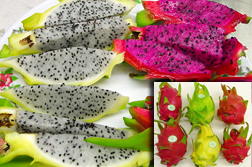This page has been archived and is being provided for reference purposes only. The page is no longer being updated, and therefore, links on the page may be invalid.
| Read the magazine story to find out more. |
|
|
|
See our information kit to find out more. |
|
|
Successful Tech Transfer Leads to More Hawaiian Exports
By Sean AdamsFebruary 25, 2011
Hawaii growers can now export more fruits and vegetables to the U.S. mainland, thanks to technology advanced by U.S. Department of Agriculture (USDA) scientists and cooperators.
Delicious tropical fruits and vegetables such as papaya, rambutan, longan, dragon fruit and purple-fleshed sweet potato are gaining popularity in the continental United States. But just five years ago, it would have been difficult to find these tropical delicacies in grocery stores. That's because strict quarantine restrictions and phytosanitary measures are in place to ensure agricultural pests like fruit flies don't invade the mainland.
Entomologist Peter Follett and food technologist Marisa Wall, both with the Agricultural Research Service's (ARS) U.S. Pacific Basin Agricultural Research Center in Hilo, HI, were the first to apply generic irradiation protocols to control a wide variety of quarantine insect pests found on fresh commodities. ARS is the principal intramural scientific research agency of the USDA, and this research supports the USDA priority of promoting international food security.
Working closely with colleagues from the USDA's Animal and Plant Health Inspection Service (APHIS), Hawaii Pride LLC and local growers and exporters, Follett found that a generic dose of 150 grays (Gy) of radiation is suitable for controlling the three species of tephritid fruit flies found in Hawaii. He also demonstrated a generic dose of 400 Gy is broadly effective against many other pests. These results contributed to APHIS approval of using generic doses for treatment of Hawaiian produce.
Wall examined product quality after irradiation. Her tests helped establish the maximum dose levels the fruit and vegetables could withstand while ensuring consumers receive a high-quality product.
Thanks to Follett and Wall's research, it is now easier and less costly for Hawaiian growers to share their produce with mainland consumers. As a result of their efforts, the scientists received a 2010 Federal Laboratory Consortium Award for Excellence in Technology Transfer.
This research has also helped facilitate the world-wide adoption of this technology. A handful of countries—including Mexico, India and Thailand—are currently using generic protocols on a variety of commodities.
Read more about this research in the February 2011 issue of Agricultural Research magazine.


